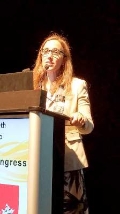FROM THE NEW ENGLAND JOURNAL OF MEDICINE
Computed tomography screening is cost effective for patients at high risk for lung cancer, according to an analysis published Nov. 5 in the New England Journal of Medicine.
Researchers examined data from the National Lung Screening Trial (NLST) and estimated that screening for lung cancer with low-dose CT would cost $81,000 per quality-adjusted life-year gained, though that number varied widely when researchers looked at specific subgroups (N. Engl. J Med. 2014;371:1793-802 [ doi:10.1056/NEJMoa1312547 ]).
The NLST, a study of more than 50,000 asymptomatic adults aged 55-74 years, showed a 16% reduction in lung cancer mortality and a 6.7% reduction in all-cause mortality when patients were screened via low-dose CT ( N. Engl. J. Med. 2013:368:1980-91 ).
“Screening with low-dose CT was much more cost-effective among women than among men and among groups with a higher risk of lung cancer than among those with a lower risk,” wrote Dr. William C. Black of Dartmouth-Hitchcock Medical Center, Lebanon, N.H., and colleagues. “Screening with low-dose CT was also more cost-effective for current smokers than for former smokers and for the older groups than for the youngest group, findings that are probably due to the higher risk of lung cancer among current smokers and older patients.”
The results of the cost-effectiveness analysis were published days in advance of an expected Centers for Medicare & Medicaid Services decision on how it will cover CT screening for lung cancer.
For men, the cost per quality-adjusted life-year gained was $147,000, compared with $46,000 in women. Those who were aged 60-64 years had the lowest cost per quality-adjusted life-year gained of $48,000, with those aged 65-69 years at $54,000. However, the cost per quality-adjusted life-year gained reached $117,000 for those aged 70-74 years and $152,000 for those aged 55-59 years.
Smoking status also had a wide variation, with the cost per quality-adjusted life-year gained for current smokers at $43,000, while those who were former smokers had a cost per quality-adjusted life-year gained of $615,000.
In December 2013, the U.S. Preventive Services Task Force gave low-dose CT screening for patients at high risk of lung cancer a “B” recommendation, meaning that the task force recommends the service and has a “high certainty that the net benefit is moderate or there is moderate certainty that the net benefit is moderate to substantial.” Under the Affordable Care Act, “A” and “B” recommendations from the task force must be covered by insurers at no cost to patients.
However, earlier this year, members of the Medicare Evidence Development and Coverage Advisory Committee recommended that Medicare not cover screening, saying that on average, they had low confidence that there is adequate evidence that the benefits outweigh the harms of low-dose CT screening in the Medicare population.
“The determination of whether screening outside the trial will be cost-effective will depend on how screening is implemented,” Dr. Black and his colleagues concluded.




